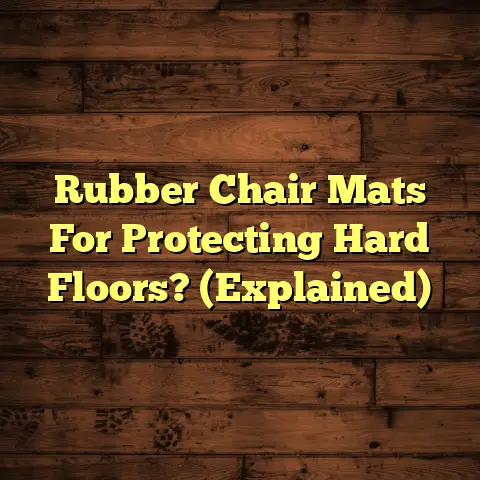Enhance Laminate Flooring (8 Must-Have Add-Ons!)
As a flooring contractor with years of experience, I’ve seen firsthand the growing demand for sustainable options. More and more homeowners are seeking eco-friendly solutions, and laminate flooring fits the bill perfectly.
Laminate is a fantastic choice because it often incorporates recycled materials in its construction. Plus, it’s incredibly durable. This means fewer replacements and less waste ending up in landfills. Think of it as a win-win for your home and the environment!
But here’s the thing: laminate flooring can be even better. That’s where add-ons come in. I’m talking about those extra touches that not only boost the look and feel of your floors but also contribute to a greener lifestyle.
Ready to dive in? I’ll walk you through eight must-have add-ons that will transform your laminate flooring into a sustainable showstopper. Let’s get started!
Section 1: Underlayment
Okay, let’s kick things off with a crucial component: underlayment. What is it, exactly? Underlayment is that layer of material you install between the subfloor and your laminate planks.
Think of it as a silent hero, working hard behind the scenes. Its primary purpose is to provide a smooth, even surface for the laminate, minimizing imperfections in the subfloor.
But that’s not all! A good underlayment also offers:
- Sound insulation: Reduces noise transmission, which is especially important in apartments or multi-story homes.
- Moisture control: Acts as a barrier against moisture from the subfloor, preventing warping and damage to your laminate.
- Comfort underfoot: Adds a bit of cushioning, making your floors more comfortable to walk on.
Now, here’s where sustainability comes in. Did you know you can choose eco-friendly underlayment options? Two fantastic choices are cork and recycled foam.
Cork Underlayment:
Cork is a natural, renewable resource harvested from the bark of cork oak trees. It’s naturally resistant to mold and mildew, making it an excellent choice for moisture-prone areas. Plus, it provides fantastic sound insulation.
Recycled Foam Underlayment:
Made from recycled materials like old tires or plastic bottles, recycled foam underlayment is a great way to reduce waste. It offers good sound insulation and cushioning.
Choosing the Right Underlayment
The best underlayment for you depends on your specific needs and environment.
- Basements: Opt for an underlayment with a built-in moisture barrier to protect against dampness.
- High-Traffic Areas: Choose a dense underlayment that can withstand heavy foot traffic and provide good impact resistance.
- Apartments/Condos: Prioritize sound insulation to minimize noise complaints from your neighbors.
My Recommendation:
I’ve personally used both cork and recycled foam underlayment on various projects, and I’ve been consistently impressed. For example, I recently installed laminate flooring in a client’s basement using a recycled foam underlayment with a moisture barrier. The client was thrilled with the results, noting the added comfort and the peace of mind knowing their floors were protected from moisture.
Pro Tip: Always check the manufacturer’s recommendations for the specific laminate flooring you’re using. They may have specific requirements for underlayment thickness and type.
Section 2: Floor Protectors
Alright, let’s talk about protecting your investment! Laminate flooring is durable, but it’s not invincible. Scratches and dents can happen, especially in high-traffic areas or under heavy furniture.
That’s where floor protectors come in. These little gems are designed to prevent damage by creating a barrier between your furniture and the floor.
Types of Floor Protectors
- Felt Pads: These are the most common type of floor protector. They’re inexpensive and easy to install. Simply stick them to the bottom of your furniture legs.
- Rubber Casters: Ideal for furniture with wheels, rubber casters provide a smooth, quiet glide while protecting your floors from scratches.
- Plastic Cups: Perfect for heavy furniture like sofas and beds, plastic cups distribute weight evenly, preventing dents.
Sustainable Options
You might be wondering, “Are there sustainable floor protectors?” Absolutely! Look for options made from recycled materials. Some companies even offer felt pads made from recycled wool.
My Experience
I once had a client who was constantly rearranging her furniture. She was worried about scratching her new laminate floors. I recommended felt pads made from recycled materials. She loved them! Not only did they protect her floors, but she also felt good knowing she was making an eco-conscious choice.
Pro Tip: Regularly check your floor protectors for wear and tear. Replace them as needed to ensure continued protection.
Section 3: Area Rugs
Now, let’s add some style and comfort! Area rugs are a fantastic way to enhance the aesthetic appeal of your laminate flooring while adding warmth and coziness to your space.
Benefits of Area Rugs
- Aesthetic Appeal: Area rugs can add color, pattern, and texture to your room, complementing your laminate flooring and décor.
- Comfort and Warmth: Rugs provide a soft, warm surface underfoot, making your space more inviting.
- Noise Reduction: Area rugs can absorb sound, reducing noise levels in your home.
- Floor Protection: Rugs can protect your laminate flooring from scratches and wear in high-traffic areas.
Sustainable Rug Options
When choosing an area rug, consider sustainable options made from natural fibers or recycled materials.
- Natural Fibers: Look for rugs made from wool, cotton, jute, sisal, or hemp. These materials are renewable and biodegradable.
- Recycled Materials: Some rugs are made from recycled plastic bottles or other recycled materials. These rugs are durable and eco-friendly.
Choosing the Right Rug
- Size: Choose a rug that is proportional to the size of your room and furniture.
- Style: Select a rug that complements your décor and personal style.
- Placement: Consider the function of the room and place the rug accordingly. For example, in a living room, you might place the rug under the front legs of your sofa and chairs.
My Experience
I helped a client choose an area rug for her living room with laminate floors. We opted for a rug made from recycled plastic bottles. It was incredibly soft and durable, and it added a pop of color to the room. She was thrilled with the results and loved that it was an eco-friendly choice.
Pro Tip: Use a rug pad underneath your area rug to prevent slipping and protect your laminate flooring from scratches.
Section 4: Transition Strips
Transition strips are essential for creating smooth, seamless transitions between different flooring types. They’re those little pieces of trim that bridge the gap between laminate and other surfaces like tile, carpet, or hardwood.
Importance of Transition Strips
- Safety: Transition strips prevent tripping hazards by creating a smooth, even surface.
- Aesthetics: They provide a clean, finished look to your flooring installation.
- Protection: They protect the edges of your flooring from damage.
Materials for Transition Strips
Transition strips are available in a variety of materials, including:
- Wood: Provides a classic, natural look.
- Metal: Durable and long-lasting, often used in commercial settings.
- Laminate: Matches your laminate flooring for a seamless look.
- Vinyl: A budget-friendly option that is water-resistant.
Sustainable Options
When choosing transition strips, look for sustainable options made from:
- Reclaimed Wood: Gives new life to old wood, reducing waste.
- Recycled Materials: Some transition strips are made from recycled plastic or other recycled materials.
Installation and Maintenance
Transition strips are relatively easy to install. Most come with pre-drilled holes and screws. Simply align the strip between the two flooring types and screw it into place.
To maintain your transition strips, simply clean them regularly with a damp cloth. Avoid using harsh chemicals that could damage the finish.
My Experience
I once installed laminate flooring in a client’s kitchen that transitioned to tile in the adjacent hallway. We used a transition strip made from reclaimed wood to create a seamless, eco-friendly transition. The client loved the rustic look and the fact that it was a sustainable choice.
Pro Tip: Choose a transition strip that matches or complements your laminate flooring and the adjacent flooring type.
Section 5: Baseboards and Moldings
Baseboards and moldings are the finishing touches that complete the look of your laminate flooring. They cover the gap between the floor and the wall, creating a clean, polished appearance.
Role of Baseboards and Moldings
- Aesthetics: Baseboards and moldings add visual interest and enhance the overall design of your room.
- Protection: They protect the walls from damage caused by furniture or foot traffic.
- Concealment: They hide imperfections in the wall or floor.
Sustainable Materials
When choosing baseboards and moldings, consider sustainable options made from:
- Reclaimed Wood: Adds character and reduces waste.
- Low-VOC Finishes: Minimizes harmful emissions into your home.
- FSC-Certified Wood: Ensures that the wood comes from responsibly managed forests.
Styles and Designs
Baseboards and moldings are available in a variety of styles and designs, from simple and modern to ornate and traditional. Choose a style that complements your laminate flooring and the overall aesthetic of your home.
My Experience
I recently installed laminate flooring in a client’s living room. We used baseboards made from reclaimed wood and finished them with a low-VOC sealant. The client was thrilled with the results, noting the unique character of the reclaimed wood and the eco-friendly aspect.
Pro Tip: When installing baseboards and moldings, use a miter saw to create clean, precise cuts.
Section 6: Floor Maintenance Products
Keeping your laminate floors looking their best requires proper maintenance. But before you reach for any old cleaner, it’s essential to choose eco-friendly products specifically designed for laminate.
Importance of Eco-Friendly Products
Traditional floor cleaners often contain harsh chemicals that can damage your laminate flooring and release harmful fumes into your home. Eco-friendly options, on the other hand, are made with natural ingredients that are safe for your floors and the environment.
Sustainable Brands and Products
Look for brands that prioritize sustainability and use plant-based ingredients. Here are a few things to keep in mind when choosing floor maintenance products:
- Avoid harsh chemicals: Look for products that are free of bleach, ammonia, and other harsh chemicals.
- Choose pH-neutral cleaners: These are gentle on your laminate flooring and won’t damage the finish.
- Look for certifications: Certifications like EcoLogo or Green Seal indicate that the product meets certain environmental standards.
Maintenance Schedule and Tips
- Sweep or vacuum regularly: This will remove dirt and debris that can scratch your laminate flooring.
- Mop with a damp cloth: Use a pH-neutral cleaner and a damp (not wet) cloth to mop your floors.
- Clean up spills immediately: Wipe up spills as soon as they happen to prevent staining.
- Avoid abrasive cleaners: These can scratch your laminate flooring.
My Experience
I’ve been using eco-friendly floor cleaners on my own laminate floors for years, and I’ve been consistently impressed with the results. My floors look great, and I feel good knowing that I’m not exposing my family to harmful chemicals.
Pro Tip: Always test new cleaning products on a small, inconspicuous area of your laminate flooring before using them on the entire floor.
Section 7: Lighting Solutions
Believe it or not, lighting can dramatically enhance the look of your laminate flooring. The right lighting can highlight the texture and color of your floors, creating a warm and inviting atmosphere.
Sustainable Lighting Options
When it comes to lighting, there are many sustainable options to choose from. LED fixtures are a great choice because they use significantly less energy than traditional incandescent bulbs.
Benefits of LED Lighting
- Energy Efficiency: LEDs use up to 80% less energy than incandescent bulbs.
- Long Lifespan: LEDs can last for up to 25,000 hours, reducing the need for frequent replacements.
- Cool to the Touch: LEDs produce very little heat, making them safer to use.
Strategic Lighting Placement
- Highlight Texture: Use spotlights or track lighting to highlight the texture of your laminate flooring.
- Create Ambiance: Use dimmer switches to adjust the brightness of your lights and create a warm, inviting atmosphere.
- Use Natural Light: Maximize natural light by opening curtains and blinds during the day.
My Experience
I recently helped a client redesign their living room with laminate flooring. We installed LED recessed lighting and added dimmer switches. The client was amazed at how the lighting transformed the room, making the laminate floors look even more beautiful.
Pro Tip: Consider using smart lighting systems that allow you to control your lights from your smartphone or tablet.
Section 8: Smart Home Integration
Last but not least, let’s talk about smart home integration. Smart home technology can seamlessly integrate with your laminate flooring, enhancing comfort, convenience, and energy efficiency.
Sustainable Smart Home Solutions
- Smart Thermostats: These thermostats learn your heating and cooling preferences and automatically adjust the temperature to save energy.
- Energy-Efficient Appliances: Choose appliances with high energy efficiency ratings to reduce your energy consumption.
- Smart Lighting: As mentioned earlier, smart lighting systems can help you save energy and create a more comfortable living environment.
How Smart Home Technology Works with Laminate Flooring
- Temperature Control: Smart thermostats can help maintain a consistent temperature, preventing warping or damage to your laminate flooring.
- Energy Savings: By reducing energy consumption, smart home technology can help lower your utility bills and reduce your environmental impact.
- Comfort and Convenience: Smart home technology can make your life easier and more comfortable.
My Experience
I recently installed laminate flooring in my own home and integrated it with a smart thermostat and smart lighting system. I’ve been amazed at how much energy I’ve saved, and I love the convenience of being able to control everything from my smartphone.
Pro Tip: When choosing smart home technology, look for products that are compatible with your existing systems and appliances.
Conclusion
So, there you have it! Eight must-have add-ons to enhance your laminate flooring while embracing sustainability. From eco-friendly underlayment to smart home integration, these enhancements not only improve the aesthetic and functional qualities of your flooring but also contribute to a greener lifestyle.
I hope this article has inspired you to consider these enhancements for your own home. Remember, making informed choices can positively impact both your living space and the planet. Let’s create beautiful, sustainable homes together!





